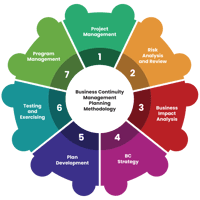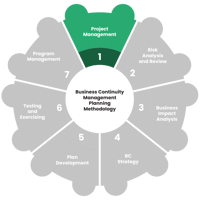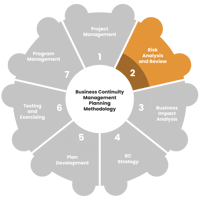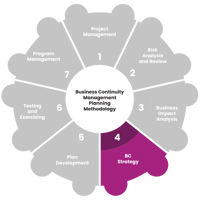eBook 2: Chapter 1
Implementing Business Continuity Management Planning Methodology for the Singapore Institute of Technology
Introduction
The Singapore Institute of Technology (SIT), Singapore’s first University of Applied Learning, is committed to providing an industry-focused education that integrates learning, applied research, and innovation.
As a key national institution supporting Singapore’s SkillsFuture movement, SIT plays a crucial role in ensuring learning continuity across diverse teaching modalities, digital platforms, and operational environments.
In alignment with ISO 22301:2019 – Security and Resilience – Business Continuity Management Systems (BCMS), SIT has developed a comprehensive Business Continuity Management (BCM) Planning Methodology.
This methodology enables the University to systematically identify, assess, and manage disruptions that could affect its critical academic, administrative, and support functions.
The goal is to ensure that SIT maintains its ability to deliver high-quality education and student support, even during crises such as pandemics, IT service interruptions, campus incidents, or supply chain disruptions.
Implementing Business Continuity Management Planning Methodology
 This chapter outlines SIT’s BCM Planning Methodology, structured around seven key phases:
This chapter outlines SIT’s BCM Planning Methodology, structured around seven key phases:
- Project Management (PM)
- Risk Analysis and Review (RAR)
- Business Impact Analysis (BIA)
- Business Continuity Strategy (BCS)
- Plan Development (PD)
- Testing and Exercising (TE)
- Program Management (PgM)
Each phase aligns with the ISO 22301 framework and reflects SIT’s operational context, emphasising the safeguarding of learning continuity across its academic schools, professional clusters, and campus operations.
Project Management (PM)
 The Project Management phase establishes the foundation for SIT’s BCM implementation. It involves defining project objectives, scope, roles, and governance structures.
The Project Management phase establishes the foundation for SIT’s BCM implementation. It involves defining project objectives, scope, roles, and governance structures.
A BCM Steering Committee, chaired by the Vice President (Corporate Services), provides oversight and direction, while Business Continuity Coordinators (BCCs) from each academic cluster and administrative department coordinate BCM activities.
SIT-specific Requirement
Develop a BCM Implementation Charter approved by senior management that formally outlines responsibilities for academic, IT, and facilities units, ensuring alignment with SIT’s Learning Continuity and Digital Transformation strategies.
Risk Analysis and Review (RAR)
 In this phase, SIT identifies potential internal and external threats that could disrupt teaching, research, and administrative operations.
In this phase, SIT identifies potential internal and external threats that could disrupt teaching, research, and administrative operations.
Key risks include cybersecurity threats to e-learning platforms, power or network outages at campus data centres, and health and safety incidents affecting students or staff.
SIT-specific Requirement
Conduct an annual integrated risk assessment that includes inputs from the Office of Safety, Health, and Environment (OSHE), the IT Security Division, and academic units to assess risks to blended learning delivery and campus infrastructure.
Business Impact Analysis (BIA)
 The BIA identifies SIT’s critical business functions, determines their Maximum Acceptable Outage (MAO), and establishes Recovery Time Objectives (RTOs).
The BIA identifies SIT’s critical business functions, determines their Maximum Acceptable Outage (MAO), and establishes Recovery Time Objectives (RTOs).
Examples of critical functions include online learning systems (e.g., Learning Management System – LMS), student records management, and examination administration.
SIT-specific Requirement
Use the BIA Template for Higher Education Institutions, tailored for SIT, to capture academic and operational dependencies, including digital learning infrastructure and external vendors supporting online education.
Business Continuity Strategy (BCS)
Strategies may include cloud-based data backup and recovery, alternate campus facilities, and remote teaching arrangements.
SIT-specific Requirement
Adopt a Hybrid Learning Continuity Strategy that ensures the University can transition between on-campus, hybrid, and fully online teaching modes with minimal disruption, supported by IT resilience and academic delivery plans.
Plan Development (PD)
 The Plan Development phase consolidates strategies into actionable Business Continuity Plans (BCPs). Each academic school and administrative department develops its own BCP, which includes communication protocols, recovery procedures, and resource requirements.
The Plan Development phase consolidates strategies into actionable Business Continuity Plans (BCPs). Each academic school and administrative department develops its own BCP, which includes communication protocols, recovery procedures, and resource requirements.
SIT-specific Requirement
Ensure that each department’s BCP includes Standard Operating Procedures (SOPs) for digital learning continuity, covering access to e-learning systems, virtual classrooms, and student communications.
Testing and Exercising (TE)
 This phase validates SIT’s BCPs through tabletop exercises, simulation drills, and system failover tests. Exercises help verify the effectiveness of response procedures, resource availability, and stakeholder coordination.
This phase validates SIT’s BCPs through tabletop exercises, simulation drills, and system failover tests. Exercises help verify the effectiveness of response procedures, resource availability, and stakeholder coordination.
SIT-specific Requirement
Conduct annual BCM exercises involving both academic and administrative units. Each exercise should include an online teaching disruption scenario, such as a Learning Management System (LMS) outage, to test the Digital Learning Continuity Plan.
Program Management (PgM)
 The Program Management phase ensures that BCM remains a living and sustainable program at SIT. It includes periodic reviews, continual improvement, training, and management reporting.
The Program Management phase ensures that BCM remains a living and sustainable program at SIT. It includes periodic reviews, continual improvement, training, and management reporting.
The BCM program is aligned with SIT’s Strategic Plan and Governance Framework, ensuring integration with risk management and IT resilience.
SIT-specific Requirement
Implement a BCM Annual Review Cycle, coordinated by the Office of Strategic Planning and Institutional Research (SPIR), to update BCPs, verify staff training, and track audit findings, in alignment with ISO 22301 compliance requirements.
The Singapore Institute of Technology’s BCM Planning Methodology reflects its proactive commitment to institutional resilience and educational excellence.
By embedding ISO 22301 principles into its operational framework, SIT ensures learning continuity, protects critical functions, and maintains its mission to nurture industry-ready graduates, even in the face of disruptions.
Through continuous review, stakeholder engagement, and integration with digital transformation initiatives, SIT strengthens its capacity to anticipate, respond to, and recover from crises — ensuring that both students and staff can thrive in a secure and resilient learning environment.




![BCM E2 PM [Introduction BCM Planning Methodology] Banner](https://blog.bcm-institute.org/hs-fs/hubfs/BCM%20E2%20Blog%20Banner/BCM%20E2%20PM%20%5BIntroduction%20BCM%20Planning%20Methodology%5D%20Banner.png?width=1920&height=384&name=BCM%20E2%20PM%20%5BIntroduction%20BCM%20Planning%20Methodology%5D%20Banner.png)




![Register [BL-B-3]*](https://no-cache.hubspot.com/cta/default/3893111/ac6cf073-4cdd-4541-91ed-889f731d5076.png)



![FAQ [BL-B-3]](https://no-cache.hubspot.com/cta/default/3893111/b3824ba1-7aa1-4eb6-bef8-94f57121c5ae.png)
![Email to Sales Team [BCM Institute]](https://no-cache.hubspot.com/cta/default/3893111/3c53daeb-2836-4843-b0e0-645baee2ab9e.png)





